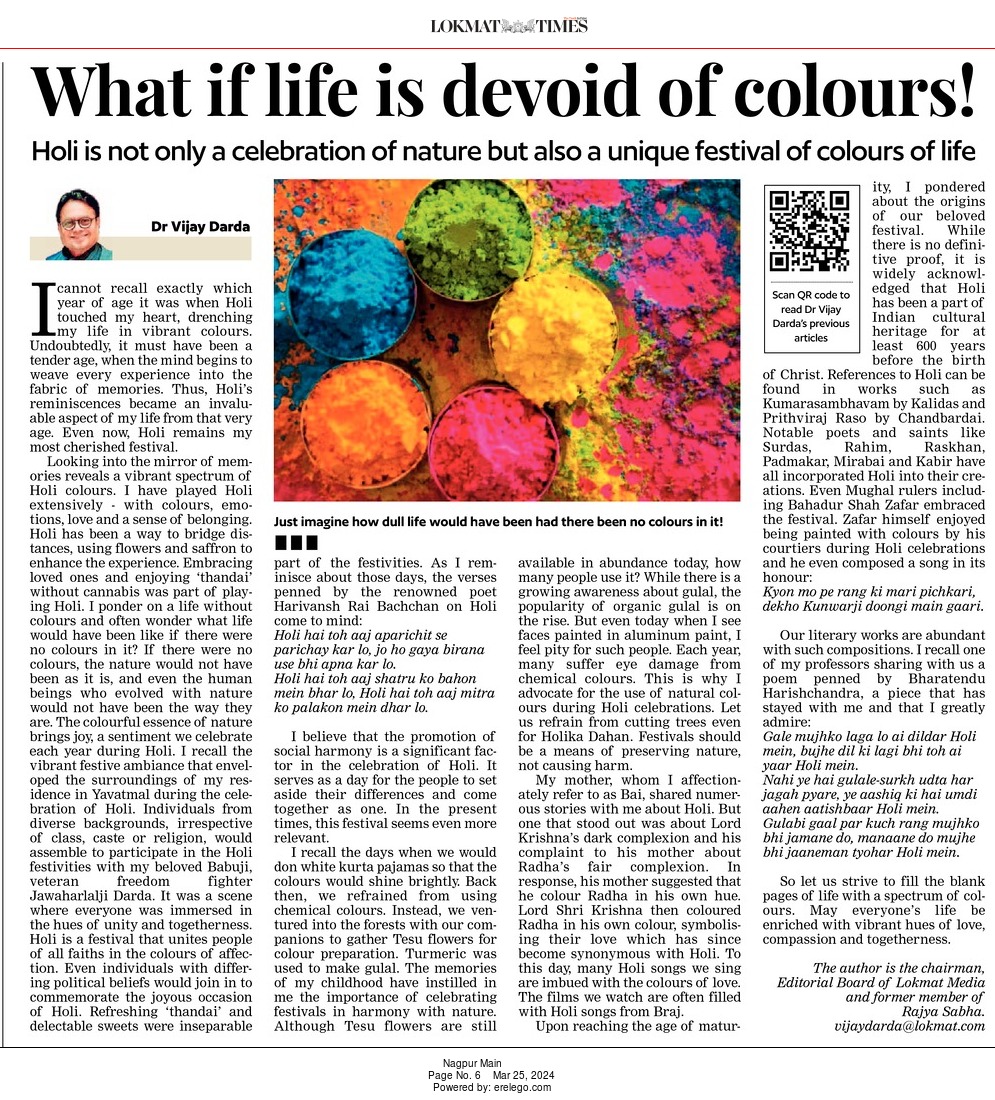What if life is devoid of colours!
 By Vijay Darda | 25-03-2024
By Vijay Darda | 25-03-2024
Holi is not only a celebration of nature but also a unique festival of colours of life
I cannot recall exactly which year of age it was when Holi touched my heart, drenching my life in vibrant colours. Undoubtedly, it must have been a tender age, when the mind begins to weave every experience into the fabric of memories. Thus, Holi’s reminiscences became an invaluable aspect of my life from that very age. Even now, Holi remains my most cherished festival.
Looking into the mirror of memories reveals a vibrant spectrum of Holi colours. I have played Holi extensively – with colours, emotions, love and a sense of belonging. Holi has been a way to bridge distances, using flowers and saffron to enhance the experience. Embracing loved ones and enjoying ‘thandai’ without cannabis was part of playing Holi. I ponder on a life without colours and often wonder what life would have been like if there were no colours in it? If there were no colours, the nature would not have been as it is, and even the human beings who evolved with nature would not have been the way they are. The colourful essence of nature brings joy, a sentiment we celebrate each year during Holi. I recall the vibrant festive ambiance that enveloped the surroundings of my residence in Yavatmal during the celebration of Holi. Individuals from diverse backgrounds, irrespective of class, caste or religion, would assemble to participate in the Holi festivities with my beloved Babuji, veteran freedom fighter Jawaharlalji Darda. It was a scene where everyone was immersed in the hues of unity and togetherness. Holi is a festival that unites people of all faiths in the colours of affection. Even individuals with differing political beliefs would join in to commemorate the joyous occasion of Holi. Refreshing ‘thandai’ and delectable sweets were inseparable part of the festivities. As I reminisce about those days, the verses penned by the renowned poet Harivansh Rai Bachchan on Holi come to mind:
Holi hai toh aaj aparichit se parichay kar lo, jo ho gaya birana use bhi apna kar lo.
Holi hai toh aaj shatru ko bahon mein bhar lo, Holi hai toh aaj mitra ko palakon mein dhar lo.
I believe that the promotion of social harmony is a significant factor in the celebration of Holi. It serves as a day for the people to set aside their differences and come together as one. In the present times, this festival seems even more relevant.
I recall the days when we would don white kurta pajamas so that the colours would shine brightly. Back then, we refrained from using chemical colours. Instead, we ventured into the forests with our companions to gather Tesu flowers for colour preparation. Turmeric was used to make gulal. The memories of my childhood have instilled in me the importance of celebrating festivals in harmony with nature. Although Tesu flowers are still available in abundance today, how many people use it? While there is a growing awareness about gulal, the popularity of organic gulal is on the rise. But even today when I see faces painted in aluminum paint, I feel pity for such people. Each year, many suffer eye damage from chemical colours. This is why I advocate for the use of natural colours during Holi celebrations. Let us refrain from cutting trees even for Holika Dahan. Festivals should be a means of preserving nature, not causing harm.
My mother, whom I affectionately refer to as Bai, shared numerous stories with me about Holi. But one that stood out was about Lord Krishna’s dark complexion and his complaint to his mother about Radha’s fair complexion. In response, his mother suggested that he colour Radha in his own hue. Lord Shri Krishna then coloured Radha in his own colour, symbolising their love which has since become synonymous with Holi. To this day, many Holi songs we sing are imbued with the colours of love. The films we watch are often filled with Holi songs from Braj.
Upon reaching the age of maturity, I pondered about the origins of our beloved festival. While there is no definitive proof, it is widely acknowledged that Holi has been a part of Indian cultural heritage for at least 600 years before the birth of Christ. References to Holi can be found in works such as Kumarasambhavam by Kalidas and Prithviraj Raso by Chandbardai. Notable poets and saints like Surdas, Rahim, Raskhan, Padmakar, Mirabai and Kabir have all incorporated Holi into their creations. Even Mughal rulers including Bahadur Shah Zafar embraced the festival. Zafar himself enjoyed being painted with colours by his courtiers during Holi celebrations and he even composed a song in its honour:
Kyon mo pe rang ki mari pichkari, dekho Kunwarji doongi main gaari.
Our literary works are abundant with such compositions. I recall one of my professors sharing with us a poem penned by Bharatendu Harishchandra, a piece that has stayed with me and that I greatly admire:
Gale mujhko laga lo ai dildar Holi mein, bujhe dil ki lagi bhi toh ai yaar Holi mein.
Nahi ye hai gulale-surkh udta har jagah pyare, ye aashiq ki hai umdi aahen aatishbaar Holi mein.
Gulabi gaal par kuch rang mujhko bhi jamane do, manaane do mujhe bhi jaaneman tyohar Holi mein.
Relevant Articles
